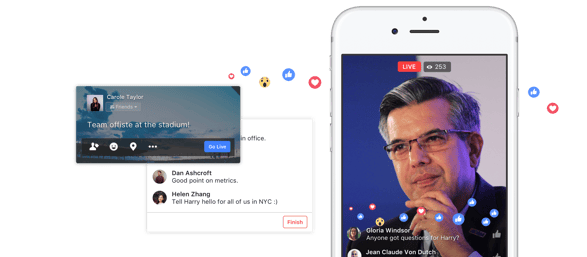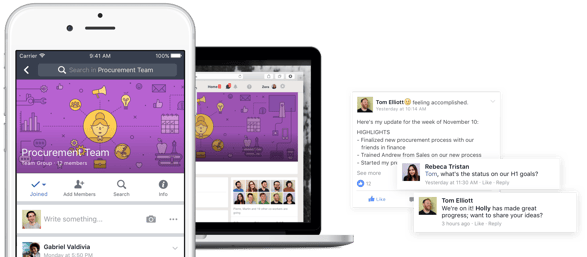Change is hard. Even with something that seems so easy to use, and especially when it comes to implementing new technology that promises to change the way a company works. When it comes to running a successful Workplace by Facebook implementation, taking deliberate care to address specific issues can overcome the inevitable obstacles that arise in any software deployment. After all, employees have developed habits working in the current way and anything that disrupts those habits will meet resistance.
We put this resistance to the test at ServiceRocket when we implemented Workplace by Facebook.
Anyone that has participated in software deployments knows that there are many ways to get software adopted. Companies are unique and require their own brand of implementation. However, there are common elements of successful software rollouts that are minimum requirements even if each element is performed in a different way.
In this blog, I discuss six elements of a successful Workplace implementation. These six elements are not sufficient conditions, but they are necessary. Consider them a minimum requirement for a successful implementation.
Executive leadership, not buy-in

It is commonly understood that successful change initiatives in organizations require executive buy-in at the highest level. But buy-in is not enough. What successful implementations require is leadership from an executive sponsor. Leadership in the form of actively and proactively pulling the change through the organization. Not pushing it on people, but pulling it into people’s workflow.
One of the secrets to the success of our Workplace implementation was that ServiceRocket founder and CEO, Rob Castaneda, was actively, proactively, and directly involved in the implementation. Not only was Rob highly involved from the beginning, but he expressed his excitement in both using the tool and in the “hallways” at work. In one example, Rob immediately changed the way he conducted our all-hands meetings. Using his phone, he recorded his presentation and then posted that on Workplace. Now all employees could watch the video of the presentation, then the live all-hands meetings for each office could spend the majority of time of Q&A and less time on one-way communication.
Yes. We flipped the all-hands meeting.
In other words, Rob immediately changed how he performed a specific type of work (the all hands meeting) and demonstrated one way to use Workplace that all could see. It was a demonstration of leadership, not buy-in.
Build a team of early adopters
Leadership at the executive level is not enough. The larger the organization, the further away people are from the influence of the executive team. And leadership needs to be as close to the action as possible. One way to gain leadership on the front lines is to build a small team of early adopters, empower them, before anyone else, to lead the way with the new tool, and then unleash them in the organization to lead the way with enthusiasm and persistence. The idea here is to tell this group, “You are an elite group. You are the champions. And we need you to make this implementation successful.”
At the very beginning of our implementation, we assembled a small team of champions who did three things:
- Started using Workplace every day for actual work
- They pulled colleagues into their work, actually telling colleagues, “If you need to reach me, message me on Workplace.” In other cases, when one of the champions received an email from someone, that champion to reply in Workplace.
- This team also deprecated existing communication channels (email distribution lists and specific groups in other ChatOps tools sending a visible signal that communication around a particular topic has moved to Workplace.
Even in the face of resistance, and there was resistance, the champions persisted in bringing people along in a positive and enthusiastic way.
Burn (some) ships
One major problem with any change initiative is distractions. Anything new in an organization is (or should be) designed to replace an existing means of working. However, for a certain period of time, both workflows are operating at the same time. While people are working in the current way, they are being asked to start working in a new way. This can often seem like twice as much work. At the very least, it is a distraction, which can slow down productivity and leave people frustrated.
People often react by resisting or rejecting the new way.
Organizations need to make the transition as quickly as possible but without cutting the old ways too early.
It is a delicate balance.
One way we did this during our Workplace implementation was to deprecate a few, specific communications channels, leaving no other choice but to communicate on specific topics in Workplace. For example, our marketing team moved all team communications to Workplace and told the entire company that to communicate with marketing, everyone must now do so on Workplace.
We did not do this cold turkey for the entire organization. We started with an early adopter team and with one small communication channel, as a means for showing a visible transition.
As you think about how you would execute burning ships, one example is to remove email distribution lists. The mistake is keeping both for too long allowing people to reject the new distraction.
Create groups for teams

When you go live with Workplace, you must have Groups already created that reflect current reality in your organization and that reflect the three layers of work that exist in your organization. The three layers of work in organizations are the:
- Social layer: the watercooler and hallway discussions
- Communication/Messaging layer: Broadcasting messages in the company
- Work layer: Conversations around actual work
When you launch Workplace, you need groups for each of these layers so that your people know where to go to have these engagements.
At ServiceRocket, we created the following group types:
Social Layer: We created a group for each office location, and empowered people to created their own groups, like a Cycling Club group, and Fantasy Football groups, and a Toastmasters group, for example.
Communications / Messaging Layer: We created a CEO group, in which ServiceRocket founder and CEO, Rob Castaneda, posts messages about the company direction, culture, reflections on the company, customers, and the market. We also created groups for each team, in which teams could communication over issues they care about most.
Work Layer: Right away we created a cross-functional customer project group to work on a specific customer software implementation. Team members discuss the project and share links documents and other work products. More project groups followed.
There is a lot of overlap in the types of conversations that occur in each of these groups, but each group does have an obvious and visible main purpose.
Get that profile picture up
The first action we wanted everyone to take was to set up their profile, and more specifically to get their profile picture up. Connecting a name with a face is an important element of relationship building and since ServiceRocket is distributed among four global offices, plus a few people who work at home, seeing pictures in profiles when communicating in Workplace by Facebook is very important.
Rob repeatedly asked people to put up their profile photos and repeatedly asked managers to ask their teams to get their profile pictures up.
Address resistance
As with any change initiative, there will be resistance. No matter how great the software is or how savvy your team is, you will encounter resistance. And you must address it. Resistance to change is nothing new. This is what Paul Lawrence wrote about resistance to change in a 1969 issue of Harvard Business Review, “One of the most baffling and recalcitrant of the problems which business executives face is employee resistance to change.”
The more things change, the more they stay the same, right?
Successful implementations anticipate this resistance, plan for it, and address it proactively. Although there are many ways to deal with change, most of the methods fall into three categories.
First you must address why the change is happening. Then you need to paint a clear picture of where the change is headed. Finally, people need to understand what it will take to get to that future, improved state.
Your project risks failure if the change issue is not addressed proactively.
A proactive, deliberate approach
Even though it is our business to implement software and help companies achieve desired adoption rates, when it came time to implementing new software for ourselves, we reminded ourselves not to take the process for granted. Even we took a deliberate approach in order to produce a successful Workplace implementation.
Implement Workplace by Facebook in Your Organization
We believe so much in the power of Workplace to help create open and connected workplace that we help our customers implement and adopt Workplace. If you’d like to learn more, contact us.
